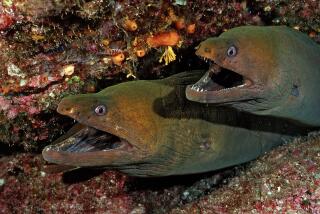Ethereal, 8-foot-long ‘sea serpent’ caught on video
- Share via
Scientists have released video of an 8-foot-long, shimmering oarfish taken about 200 feet below the ocean surface -- and it is breathtaking.
Elusive and alien-looking, the oarfish has a thin, eel-like body with squiggly iridescent markings that glow blue in the video. It also has a long dorsal fin that stretches the length of nearly half its body, and large round eyes rimmed in silver.
That bright white blob you see in the fish’s spiny dorsal fins is a parasitic isopod -- sort of like an ocean version of the roly poly bug -- that has attached itself to the fish. It is a common parasite of marine fish, but it is the first time one has been seen on an oarfish, said Mark Benfield, a marine biologist at Louisiana State University.
Benfield is the lead author of a paper describing the oarfish video, published in a recent issue of the Journal of Fish Biology.
Despite its great size, the fish orients itself vertically, with its head toward the ocean surface, and its blunt tail hanging down. This allows the fish to scan the water above for the krill and other small crustaceans that it eats, and may help it appear smaller to predators who are lurking below, said Benfield.
“The striking thing is they swim by undulating their dorsal fin like a propeller, and they can change direction instantly,” Benfield said. “Most of the time they move slowly and stealthily, but when they want to, they can move fast.”
Benfield’s research usually leans toward small sea animals such as zooplankton and shrimp. But since 2006 he has been working with several oil companies stationed in the Gulf of Mexico who have agreed to give him time on their remotely operated vehicles (ROVs) to scan the waters for marine life through a project called GulfSERPENT.
The ROVs, which are usually used to find new sources of oil, are not ideal for finding wildlife. They are noisy and large, about the size of small cars, and they shine bright lights and lasers at whatever they see. But Benfield said it is easier to get time on the hundreds of ROVs owned by oil companies stationed in the Gulf Coast than it is on the handful of ROVs around the world that are devoted to scientific research. Since he started working with the oil companies, he has collected about 40 hours of undersea footage from the Gulf Coast a week.
Since 2008, Benfield has captured video of the oarfish on four different occasions through the SERPENT project. The most recent video of the oarfish, shot in 2011, was collected when Benfield was working with the Natural Resource Damage Assessment group to determine the impact of the Deepwater Horizon oil spill.
“We were just finishing up scanning the water column about 200 feet below the surface when my technician yelled,” said Benfield. “I walked into the lab and saw this giant oarfish. I was like, ‘Oh my God,’ and we followed that thing for 10 minutes.”
When you watch the video below, keep in mind that the oarfish is looking at a large, bright, noisy object in the water that is unlike anything that occurs in its natural environment.
“It starts by backing away from us tail-first, and then finally it got fed up and took off,” said Benfield.
The fish shimmers in and out of view for the first few minutes of the video below. If you don’t have time to watch the whole thing, I suggest starting at the five-minute mark to get a good look at it, and then fast-forwarding to the nine-minute mark where you can see it zip away like an underwater lightning streak.







